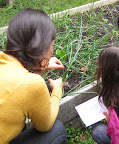Searching for evidence of animals using plants for food or shelter
By Peggy Ashbrook
Posted on 2013-05-28
What can tell us if an animal is using a plant for food or for a place to rest or live? What will we see if a caterpillar has been eating a leaf a bird has been roosting on a tree branch? These questions were posed to kindergarten and first grade classes who were about to walk around the school grounds.

 The young children went on a “nature walk” looking for evidence and they found it: holes in leaves, insect eggs on a leaf, bird “doo-doo” and ants going into holes in trees. By drawing their observations, the children were able to refer back to them when they returned to the classroom. Discussion with the teacher in the field prepared the children to discuss with other students back in the classroom.
The young children went on a “nature walk” looking for evidence and they found it: holes in leaves, insect eggs on a leaf, bird “doo-doo” and ants going into holes in trees. By drawing their observations, the children were able to refer back to them when they returned to the classroom. Discussion with the teacher in the field prepared the children to discuss with other students back in the classroom.
Sitting in a whole class circle, the kindergartners were reminded that they were going to talk together by taking turns. They were asked to share their evidence of animals using plants for food or shelter. Ms Tingler sat back, occasionally acknowledging the next speaker and giving reminders to speak to all (not just the teacher), and the children shared what they saw and thought. They thought that some animal (maybe a caterpillar) had been eating those leaves, and the bird that made the droppings might have been sitting on the branch above, and the ants were using the tree as shelter. There was a lot of repetition, reinforcing the group nature walk experience.
The student science talk shows their beginning understanding that patterns in the natural world (holes in leaves) can be observed and used as evidence, and that animals need food in order to live and grow—part of the practices, core ideas and crosscutting concepts defined in the Next Generation Science Standards.
When asked if we humans are animals, some children said yes, some said no, and some said “Kind of like animals.” To try to clarify their thinking, I asked, “Are people in the same group as animals or as plants?” Evidence given for being plants was that babies come out from mothers, just as seeds come from fruits. Evidence given for being animals was that we have “fur” and eyes, ears, mouth and nose, “like animals.” The children made a great start discussing the question. Further investigation and collecting evidence will be the basis of more discussion. I think they will conclude that people are animals, and like plants, are living organisms that reproduce.
Disclaimer: The views expressed in this blog post are those of the author(s) and do not necessarily reflect the official position of the National Science Teaching Association (NSTA).


